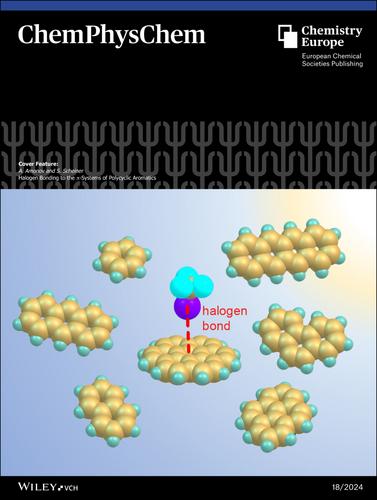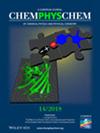Cover Feature: Halogen Bonding to the π-Systems of Polycyclic Aromatics (ChemPhysChem 18/2024)
IF 2.3
3区 化学
Q3 CHEMISTRY, PHYSICAL
引用次数: 0
Abstract
Replacement of the bridging hydrogen of the H-bond by a halogen atom (X) such as Br or I leads to a CX⋅⋅⋅B halogen bond. Most such halogen bonds extract electron density from a lone pair of the B nucleophile. However, the extended π-electron cloud of an aromatic system like benzene or its larger polycyclic cousins such as naphthalene, anthracene, and coronene can also act as the nucleophile in such halogen bonds, with bond strengths that rival traditional halogen and hydrogen bonds. More information can be found in the Research Article by A. Amonov and S. Scheiner (DOI: 10.1002/cphc.202400482).

封面专题:多环芳烃π系统的卤素键合(ChemPhysChem 18/2024)
卤素原子(X)(如 Br 或 I)取代 H 键的桥氢会形成 CX⋅⋅B 卤素键。大多数此类卤素键都从 B 亲核体的孤对电子中提取电子密度。不过,苯等芳香系统或其较大的多环系统(如萘、蒽和冠烯)的扩展 π 电子云也可在此类卤素键中充当亲核体,其键强度可与传统的卤素键和氢键相媲美。更多信息,请参阅 A. Amonov 和 S. Scheiner 的研究文章(DOI: 10.1002/cphc.202400482)。
本文章由计算机程序翻译,如有差异,请以英文原文为准。
求助全文
约1分钟内获得全文
求助全文
来源期刊

Chemphyschem
化学-物理:原子、分子和化学物理
CiteScore
4.60
自引率
3.40%
发文量
425
审稿时长
1.1 months
期刊介绍:
ChemPhysChem is one of the leading chemistry/physics interdisciplinary journals (ISI Impact Factor 2018: 3.077) for physical chemistry and chemical physics. It is published on behalf of Chemistry Europe, an association of 16 European chemical societies.
ChemPhysChem is an international source for important primary and critical secondary information across the whole field of physical chemistry and chemical physics. It integrates this wide and flourishing field ranging from Solid State and Soft-Matter Research, Electro- and Photochemistry, Femtochemistry and Nanotechnology, Complex Systems, Single-Molecule Research, Clusters and Colloids, Catalysis and Surface Science, Biophysics and Physical Biochemistry, Atmospheric and Environmental Chemistry, and many more topics. ChemPhysChem is peer-reviewed.
 求助内容:
求助内容: 应助结果提醒方式:
应助结果提醒方式:


